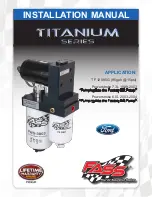
You can find further information under:
R
"M+S tyres" (
Y
page 367)
R
"Snow chains" (
Y
page 368)
R
"Driving with summer tyres" (
Y
page 367)
Also observe the notes under "Winter operation"
(
Y
page 367).
Driving in mountainous areas
!
Vehicles with a diesel engine: the oper-
ating safety of the diesel engine is guaranteed
up to an altitude of 2,500 m above sea level.
You may exceed this altitude for short peri-
ods, e.g. in mountainous terrain. Do not drive
at altitudes above 2,500 m for extended peri-
ods. You could otherwise damage the diesel
engine.
When driving in mountainous areas, note that
the power output of the engine, and with it its
gradient climbing capability, decrease with
increasing altitude. Please take note of this par-
ticularly when driving with a trailer in mountain-
ous areas.
The maximum permissible trailer loads are valid
for journeys at altitudes up to 1000 m above sea
level with gradients up to 12%.
Information on maximum permissible trailer
loads can be found in your vehicle registration
papers and on the vehicle identification plate
(
Y
page 386) or under "Trailer loads"
(
Y
page 396).
When driving at altitudes of 2500 m above sea
level or greater, the ECO start/stop function is
no longer available.
Notes on braking on downhill gradients can be
found in the "Braking" section (
Y
page 194).
Driving systems
Cruise control
General notes
Cruise control maintains the speed of the vehi-
cle for you. It brakes automatically in order to
avoid exceeding the set speed.
Use cruise control if road and traffic conditions
make it appropriate to maintain a steady speed
for a prolonged period. You can set any speed
from 30 km/h upwards in increments of 1 km/h
and 10 km/h.
If you have set
Miles
as the unit for the digital
speedometer (
Y
page 259), you can set any
speed from 20 mph in increments of 1 mph and
5 mph.
Cruise control should not be activated when
driving off-road or on construction sites.
Cruise control may be unable to maintain the
stored speed on uphill gradients. The stored
speed is resumed if the uphill gradient evens out
and the vehicle's speed does not fall below
30 km/h. Cruise control maintains the stored
speed on downhill gradients by automatically
applying the brakes. Observe the additional driv-
ing tips (
Y
page 194).
Gearshift instructions for vehicles with manual
transmission:
R
always drive at an adequate, but not exces-
sive engine speed
R
change gear in good time, particularly on
steep uphill gradients
R
do not change down several gears at a time
R
cruise control is deactivated if you depress
the clutch pedal for longer than six seconds
R
if you shift into neutral and release the clutch
pedal, the engine speed may increase con-
siderably. Deactivate cruise control before-
hand
Important safety notes
Observe the notes on braking (
Y
page 194).
If you fail to adapt your driving style or if you are
inattentive, cruise control can neither reduce
the risk of an accident nor override the laws of
physics. Cruise control cannot take road,
weather and traffic conditions into account.
Cruise control is only an aid. You are responsible
for the distance to the vehicle in front, for vehi-
cle speed, for braking in good time and for stay-
ing in lane.
If you change wheel size, make sure they corre-
spond to the correct wheel size category
(
Y
page 365). If the category is changed without
recoding the control units in the vehicle, the
functioning of cruise control may be impaired.
Driving systems
197
Driving and parking
Z
Summary of Contents for V 200 d
Page 1: ...V Class Operating Instructions Mercedes Benz V Class...
Page 400: ...398...
Page 401: ...399...
Page 402: ...400...
Page 404: ...Order no 6463 7351 02 Part no 447 584 17 03 Z102 Edition 03 17 4475841703Z1028 4475841703Z102...
















































